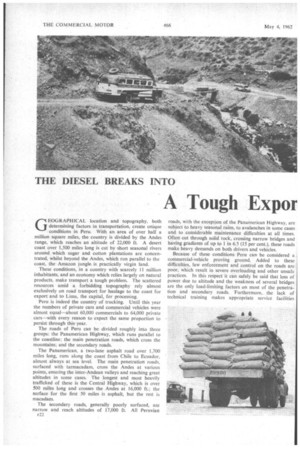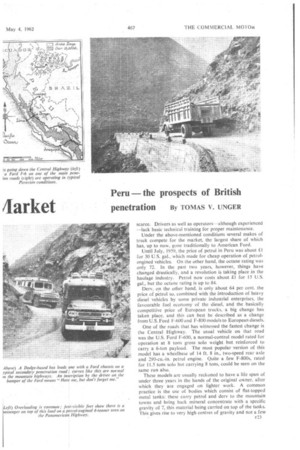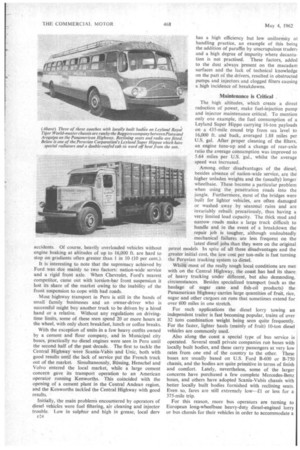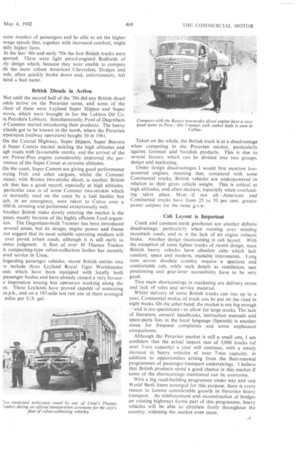A Tough Expor 4arket
Page 104

Page 105

Page 106

Page 113

If you've noticed an error in this article please click here to report it so we can fix it.
Peru the prospects of British penetration By TOMAS V. UNGER GEOGRAPHICAL location and topography, both determining factors in transportation, create unique conditions in Peru. With an area of over half a million square miles, the country is divided by the Andes range, which reaches an altitude of 22,000 ft. A desert coast over 1,500 miles long is cut by short seasonal rivers around which sugar and cotton plantations are concentrated, whilst beyond the Andes, which run parallel to the coast, the Amazon jungle is practically virgin land.
These conditions, in a country with scarcely 11 million inhabitants, and an economy which relies largely on natural products, make transport a tough problem. The scattered resources amid a forbidding topography rely almost exclusively on road transport for haulage to the coast for export and to Lima, the capital, for processing.
Peru is indeed the country of trucking. Until this year the numbers of private cars and commercial vehicles were almost equal—about 60,000 commercials to 64,000 private cars—with every reason to expect the same proportion to persist through this year.
The roads of Peru can be divided roughly into three groups: the Panamerican Highway, which runs parallel to the coastline; the main penetration roads, which cross the mountains; and the secondary roads.
The Panarnerican, a two-lane asphalt road over 1,700 miles long, runs along the coast from Chile to Ecuador, almost always at sea level. The main penetration roads, surfaced with tarmacadam, cross the Andes at various points, entering the inter-Andean valleys and reaching great altitudes in some cases. The longest and most heavily trafficked of these is the Central Highway, which is over 500 miles long and crosses the Andes at 16,000 ft.; the surface for the first 50 miles is asphalt, but the rest is macadam.
The secondary roads, generally poorly surfaced, are narrow and reach altitudes of 17,000 ft. All Peruvian F22 roads, with the exception of the Panamerican Highway, are subject to heavy seasonal rains, to avalanches in some cases and to considerable maintenance difficulties at all times. Often cut through solid rock, crossing narrow bridges and having gradients of up to 1 in 6:5 (15 per cent.), these roads make heavy demands on both drivers and vehicles.
Because of these conditions Peru can be considered a commercial-vehicle proving ground. Added to these difficulties, law enforcement and control on the roads are poor, which result in severe overloading and other unsafe practices. In this respect it can safely be said that loss of power due to altitude and the weakness of several bridges are the only load-limiting factors on most of the penetration and secondary roads. Furthermore, the lack of technical training makes appropriate service facilities scarce. Drivers as well as operators—although experienced —lack basic technical training for proper maintenance.
Under the above-mentioned conditions several makes of truck compete for the market, the largest share of which has, up to now, gone traditionally to American Ford.
Until July, 1959, the price of petrol in Peru was about £1 for 30 U.S. gal., which made for cheap operation of petrolengined vehicles. On the other hand, the octane rating was only 72. In the past two years, however, things have changed drastically, and a revolution is taking place in the haulage industry. Petrol now costs about £1 for 15 U.S. gal., but the octane rating is up to 84.
Derv, on the other hand, is only about 64 per cent. the price of petrol so, combined with the introduction of heavy diesel vehicles by some private industrial enterprises, the favourable fuel economy of the diesel, and the basically competitive price of European trucks, -a big change has taken place, and this can best be described as a change from U.S. Ford F-600 and F-800 models to European diesels.
One of the roads that has witnessed the fastest change is the Central Highway. The usual vehicle on that road was the U.S. Ford F-600, a normal-control model rated for operation at 8 tons gross solo weight but reinforced to carry a 6-ton payload. The most popular version of this model has a wheelbase of 14 ft. 8 in., two-speed rear axle and 290-cu.-in. petrol engine. Quite a few F-800s, rated for 11.5 tons solo but carrying 8 tons, could be seen on the same run also.
These models are usually reckoned to have a life span of under three years in the hands of the original owner, after which they are engaged on lighter work. A common practice is the use of bodies which consist of flat-topped metal tanks: these carry petrol and dery to the mountain towns and bring back mineral concentrate with a specific gravity of 7, this material being carried on top of the tanks.
This gives rise to very high centres of gravity and not a few accidents. Of course, heavily overloaded vehicles without engine braking at altitudes of up to 16,000 ft. are hard to stop on gradients often greater than 1 in 10 (10 per cent.).
It is interesting to note that the supremacy achieved by Ford was due mainly to two factors: nation-wide service and a rigid front axle. When Chevrolet, Ford's nearest competitor, came out with torsion-bar front suspension it lost its share of the market owing to the inability of the front suspension to cope with bad roads.
Most highway transport in Peru is still in the hands of small family businesses and an owner-driver who is successful might buy another truck to be driven by a hired hand or a relative. Without any regulations on drivingtime limits, some of these men spend 20 or more hours at the wheel, with only short breakfast, lunch or coffee breaks.
With the exception of units in a few heavy outfits owned by a cement and flour company, and in Municipal city buses, practically no diesel engines were seen in Peru until the second half of the past decade. The first to tackle the Central Highway were Scania-Vabis and Unic, both with good results until the lack of service put the French truck out of the market. Simultaneously, Bussing, Henschel and Volvo entered the local market, while a large cement concern gave its transport operation to an American operator running Kenworths. This coincided with the opening of a cement plant in the Central Andean region, and the Kenworths tackled the Central Highway with good results.
Initially, the main problem's encountered by operators of diesel vehicles were fuel filtering, air cleaning and injector trouble. Low in sulphur and high in grease, local dery F24
has a high efficiency but low uniformity ol handling practice, an example of this being the addition of paraffin by unscrupulous traders and a high degree of impurity where decantation is not practised. These factors, added to the dust always present on the macadam surfaces and the lack of technical knowledge on the part of the drivers, resulted in obstructed pumps and injectors and clogged filters causing a high incidence of breakdowns.
Maintenance is Critical ,
The high altitudes, which create a direct reduction of power, make fuel-injection pump and injector maintenance critical. To mention only one example, the fuel consumption of a Leyland Super Hippo carrying 16-ton payloads on a 435-mile round trip from sea level to 16,000 ft. and back, averaged 1.88 miles per U.S. gal. After proper cleaning of the filters, an engine tune-up and a change of rear-axle ratio the average consumption was improved to 5.64 miles per U.S. gal., whilst the average speed was increased.
Among other disadvantages of the diesel, besides absence of nation-wide service, are the higher unladen weights and the (usually) longer wheelbase. These become a particular problem when using the penetration roads into the jungle. Furthermore, most of the bridges were built for lighter vehicles, are often damaged or washed away by seasonal rains and are invariably rebuilt precariously, thus having a very limited load capacity. The thick mud and narrow roads make a large truck difficult to handle and in the event of a breakdown the repair job is tougher, although undoubtedly mechanical failures are less frequent on the latest diesel jobs than they were on the original petrol models In spite of all these disadvantages and the greater initial cost, the low cost per ton-mile is fast turning the Peruvian trucking system to diesel.
Whilst most of the really tough local conditions are met with on the Central Highway, the coast has had its share of heavy trucking under different, but also demanding, circumstances. Besides specialized transport (such as the haulage of sugar cane and fish-oil products) the Panamerican Highway carries large quantities of fruit, rice, sugar and other cargoes on runs that sometimes extend for over 600 miles in one stretch.
For such applications the diesel lorry towing an independent trailer is fast becoming popular, trains of over 32 tons combination weight being seen quite frequently. For the faster, lighter hauls (mainly of fruit) 10-ton diesel vehicles are commonly used.
Also along the coast a special type of bus service is operated. Several small private companies run buses with locally built bodies, and these carry passengers at very low rates from one end of the country to the other. These buses are usually based on U.S. Ford B-600 or B-750 chassis, and the bodies are quite primitive in terms of finish and comfort. Lately, nevertheless, some of the larger concerns have purchased a few complete Mercedes-Benz buses, and others have adopted Scania-Vabis chassis with better locally built bodies furnished with reclining seats. Even so, fares are still extremely low—fl or less for a 375-mile trip.
For this reason, more bus operators are turning to European long-wheelbase heavy-duty diesel-engined lorry or bus chassis for their vehicles in order to accommodate a
.eater number of passengers and be able to set the higher Trage speeds that, together with increased comfort, might stify higher fares.
In the late '40s and early '50s the first British trucks were tported. These were fight petrol-engined Bedfords of rly design which, because they were unable to compete ith the more robust American Chevrolets, Dodges and m-ds, often quickly broke down and, unfortunately, left :hind a bad name.
British Diesels in Action Not until the second half of the '50s did any British diesel odels arrive on the Peruvian scene, and some of the rliest of these were Leyland Super Hippos and Super :avers, which were brought in for the Lobitos Oil Co. fa Petrolera Lobitos). Simultaneously, Ford of Dagenham d Commer started introducing their products. The heavy !ylands got to be known in the north, where the Peruvian n-poration (railway operators) bought 10 in 1961.
On the Central Highway, Super Hippos, Super Beavers
d Super Comets started tackling the high altitudes and ugh roads with favourable results, and the arrival of the est Power-Plus engine considerably improved the per-mance of the Super Comet at extreme altitudes.
On the coast, Super Comets are giving good performance rrying fruit and other cargoes, whilst the Commer onner, with Rootes two-stroke diesel, is another British ick that has a good record, especially at high altitudes. particular case is of some Commer two-strokes which re normally used on the coast by a fuel haulier but Lich, in an emergency, were taken to Cuzco over a 000-ft. crossing and performed exceptionally well.
Another. British make slowly entering the market is the ames, mostly because of the highly efficient Ford organiion, The Dagenham-built 7-tonner has been introduced several areas, but its design, engine power and frame out suggest that its most suitable operating medium will over paved urban roads, although it is still early to ranee judgment. A fleet of over 30 Thames Traders h compacting-type refuse-collection bodies has recently ered service in Lima.
Zegarding passenger vehicles, recent British entries into include three Leyland Royal Tiger Worldmaster tssis which have been equipped with locally built passenger bodies and have already caused a very, favour e impression among bus operators working along the ist. These Leylands have proved capable of sustaining m.p.h., and on a 187-mile test run one of them averaged miles per U.S. gal. Taken on the whole, the British truck is at a disadvantage when competing in the Peruvian market, particularly against German and Swedish products. This is due to several factors, which can be divided into two groups: design and marketing.
Under design disadvantages I would first mention lowpowered engines, meaning that, compared with some Continental trucks, British vehicles are underpowered in relation to their gross vehicle weight. This is critical at high altitudes, and often decisive, especially when overloading takes place. Most --if not all—American and Continental trucks have from 25 to 50 per cent. greater power outputs for the same g.v.w.
Cab Layout is Important
Crash and constant-mesh gearboxes are another definite disadvantage, particularly when running over winding mountain roads, and so is the lack of an engine exhaust brake. Another design shortcoming is cab layout. With the exception of some lighter trucks of recent design, most British heavy vehicles have obsolete cabs which lack comfort, space and modern, readable instruments. Long runs across desolate country require a spacious and comfortable cab, while such details as ventilation, seat positioning and gear-lever accessibility have to be very good.
Two main shortcomings in marketing are delivery terms and lack of sales and service material.
Whilst delivery of some British trucks can run up to a year, Continental makes of truck can be put on the road in eight weeks. On the other hand, the market is not big enough —and is too specialized—to allow for large stocks. The lack of literature, owners' handbooks, instruction manuals and spare-parts lists in the local language (Spanish) is another cause for frequent complaints and some unpleasant comparisons.
Although the Peruvian market is still, a small one, I am confident that the actual import rate of 3,000 trucks (of over 5-ton capacity) a year will continue, with a steady increase in heavy vehicles of over 7-ton capacity, in addition to opportunities arising from the fleet-renewal programmes of passenger-transport undertakings. I believe that British .products stand a good chance in this market if some of the shortcomings mentioned can be overcome.
With a big road-building programme under way and vast World Bank loans arranged for this purpose, there is every reason to foresee considerable growth in Peruvian heavy transport. As reinforcement and reconstruction of bridges on existing highways forms part of this programme, heavy vehicles will be able to circulate freely throughout the country, widening the market even more.


































































































































































































































































